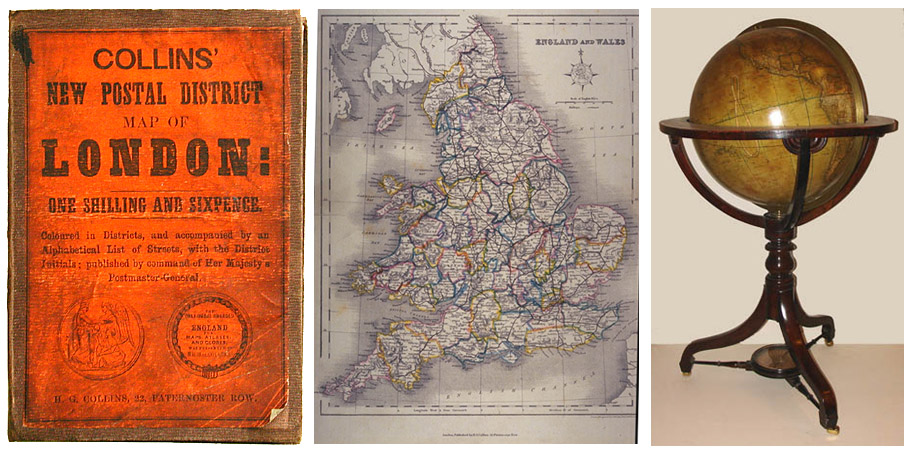
Figure 1. Examples of work produced by Henry George Collins: an atlas of London, a map of England and Wales, and a world globe.
Charles Collins, senior, 1837 – ca. 1915
by Brian Stevenson
last updated August, 2024
Charles Collins produced microscopes and other optical apparatus under his own name from 1863 until the early 1900s. He was well regarded for production of good quality, reasonably-priced equipment. His higher power lenses were considered inferior to those of high-priced makers such as Powell and Lealand, or Ross. That point would have been of little consequence to Collins’ intended clientele, the burgeoning market of medical professionals, students and amateurs who wanted quality machinery with optics sufficient to accurately examine tissues, etc. They would not have demanded the ability to measure the fine features of a diatom frustule.
William Carpenter’s 4th edition of The Microscope and its Revelations (1868) described Collins’ work, and that of comparable makers, thusly: “Several … Opticians may be named as makers of Microscopes which deserve to rank in the First Class, on account both of their Optical and of their Mechanical excellence; such are the instruments constructed by Messrs. Baker, Collins, Crouch, Dallmeyer, Ladd, Pillischer, Swift, and Wheeler. These are for the most part copied, with more or less of modification in detail, from the models either of Mr. Ross, or of Messrs. Smith and Beck; very little that is original having been introduced. The prices of these instruments, however, are usually from 10 to 20 per cent, less than those of the corresponding instruments of the original constructors; and excepting with the highest powers, little inferiority would be discovered in their performance, save by the most critical judges.” and “the following are known to the Author as furnishing Student's Microscopes of this class, at prices ranging from five to seven guineas, which can be recommended as combining really good workmanship in their mechanical portion, with an optical performance adequate to all ordinary requirements :—Messrs. Baker, Collins, Highley, How, and Wheeler”.
Charles was born June 21, 1837, the third, and last, child of Henry George and Matilda Papprill Collins. Father Henry (1808 - 1877) was a noted publisher of maps and globes during the middle 1800s. His company was not connected in any way with the Collins publishing house that exists today. Some examples of Collins’ work are shown in Figure 1. Quoting from Dyos, Cannadine and Reeder’s Exploring the Urban Past: Essays in Urban History, “Henry George Collins was one among many mapmakers and mapsellers who rose on the great tourist tide that engulfed London during and immediately following the exhibitions of 1851 and 1862. The market was a very large one. Over six million people were admitted to the Great Exhibition during the long season of 1851 (it was dismantled in 1851 and reopened at Sydenham in June 1854, ten days after Collins’ Atlas appeared). The great aim of the publicists was to make London itself an exhibition of out-of-doors, a public show requiring the entrance fee merely of the price of a pocket map – something to be understood, used, enjoyed and finally disposed of. This was a time when old maps appeared unashamedly in disguise and new editions could masquerade under new names”.

Figure 1. Examples of work produced by Henry George Collins: an atlas of London, a map of England and Wales, and a world globe.
Henry Collins patented a process known as “electro-block printing”, by which enlarged or reduced copies could be made of existing prints. This would have been useful for re-sizing hand drawn maps to be used in atlases, etc. Perhaps of equal importance, the process would simplify the “borrowing” of other people’s work that was so common in the publishing business. Collins appears to have made substantial profit from the process, in that he described his occupation on the 1861 census as “patentee of Electro Block Printing”. This clever process was described by W.T. Brande in A Dictionary of Science, Literature and Art, “By the process of electro-block printing, drawings, engravings, letterpress, or music, can be reproduced either greatly extended or reduced in size. To effect this on an enlarged scale, the surface of a sheet of vulcanised Indian rubber, equal in size to the subject, is coated with a thin film of an elastic composition, and on it is taken an impression of the print, block, or plate. This is done without difficulty, and without injury to the print from which it is taken. By means of an ingeniously contrived frame with a double-screw action, the Indian rubber is stretched equally on all sides to the size required. While retained in this form, it is laid down on a lithographic stone or zinc plate, properly prepared; and it is then in a condition to furnish impressions in the ordinary method. The reduction of objects is obtained by stretching the Indian rubber sheet of the size required till it can cover the subject; the impression being then taken, it is released from the strain and returns to its original size, and the process is continued as above described”.
Father Henry passed his publishing business on to his elder two sons William Papprill Collins (1831-1914) and Henry Edward Collins (1835 - ?) at some point before 1859. During that year, Collins Publishing filed for bankruptcy, with only those two sons listed as owners. The father and son William also owned a “fibre” factory near London, which went bankrupt in 1862. The 1861 census listed son William as being a “publisher commercial traveller”, suggesting that he had already established a new publishing company, and was then travelling the country as a salesman. William later established a bookshop that specialized in scientific materials, and operated it from the same location as his youngest brother’s microscope shop. William joined the Royal Microscopical Society in 1881. Henry Edward Collins also continued in the bookselling trade, with the 1861 census describing his as a “commercial clerk publisher”. The 1881 census recorded his as being a “commercial traveller” and “publisher”, but I could not tell whether Henry E. published his own material, or was a salesman for someone else. One of Henry E. Collins’ sons, Charles, apprenticed as a microscope maker (probably with his Uncle Charles), and operated a microscope slide-making business for about 4 years during the mid-1880s.
Early advertisements from Charles Collins indicated that he worked at the Royal Polytechnic Institute, London, prior to establishing his own business. The Institute was both a school of sciences, engineering, photography, languages and other subjects, and an entertainment center that featured lectures, dramatic readings, magic lantern shows and microscope exhibits. The Institute’s director, J.H. Pepper, wrote a letter endorsing Charles Collins’ microscopes for one of Collins’ earliest ads. I have not determined whether Collins apprenticed with one of the Institute’s microscopists, or learned his trade elsewhere.
The coincidentally-named Charles W. Collins (1807 - ca. 1880) was “philosophical instrument-maker to the Royal Polytechnic Institution”, who made “lanterns for dissolving views and microscopes”. He manufactured an oxyhydrogen (projection) microscope for Captain L.L. Boscawen Ibbetson, which was exhibited at the 1851 London Exhibition. He also wrote a book on photographic methods. C.W. Collins was probably Charles’ supervisor and mentor to some extent. He is best remembered nowadays for his magic lanterns and lantern slides.

Figure 2. Advertisement for Charles W. Collins, from the
Lancet, Vol. 1, May 1, 1852.
Brock’s biography of the physicist William Crookes noted that Crookes was a frequent visitor to the Royal Polytechnic Institute, and there met Charles Collins. Collins later built a binocular spectroscope for Crookes (see below).
The census of spring, 1861, listed the 23 year old Charles as an “optician”, living with his parents in Croydon, Surrey.
Collins appears to have opened his independent retail shop in May, 1863. The earliest advertisement I located for Collins was in the May 2, 1863 Lancet. He did not advertise in any previous issues of that journal. His shop was located at 77 Great Titchfield Street, in downtown London. Later advertisements indicate that this was also his factory.
An 1868 report of an attempted burglary of 77 Great Titchfield Street revealed that this was also the Collins’ home. The kitchen was situated on the ground floor, and living quarters were above. From the January 22 Teesdale Mercury,
“Eliza Edwards, described as a charwoman, was charged before Mr. Tyrwhitt, at Marlborough-street, on Tuesday, with the following robbery.
Mr. Charles Collins, microscope maker, of No. 77, Great Titchfield-street, said: Last night, in consequence of our dog growling, my wife, who was in the kitchen, called me downstairs, when I found the prisoner in a passage leading to the area. I asked her why she was there, and she said that a sailor, who was upstairs, had brought her. I told her to come to the kitchen while I found out more about her, and when she moved I saw at her feet, partly screened, three jackets and three dresses belonging to my servant. The prisoner pretended to be drunk, but was not.
Mr. Tyrwhitt: Was there any sailor in the house?
Mr. Collins: No, sir.
Emily Richards, servant to Mr. Collins: The articles produced are my property, and of the value of £3. I left them hanging up in my bedroom.
... Mr. Tyrwhitt: I shall send the prisoner to prison for three months with hard labour. I fear she is one of a race called area sneaks.”
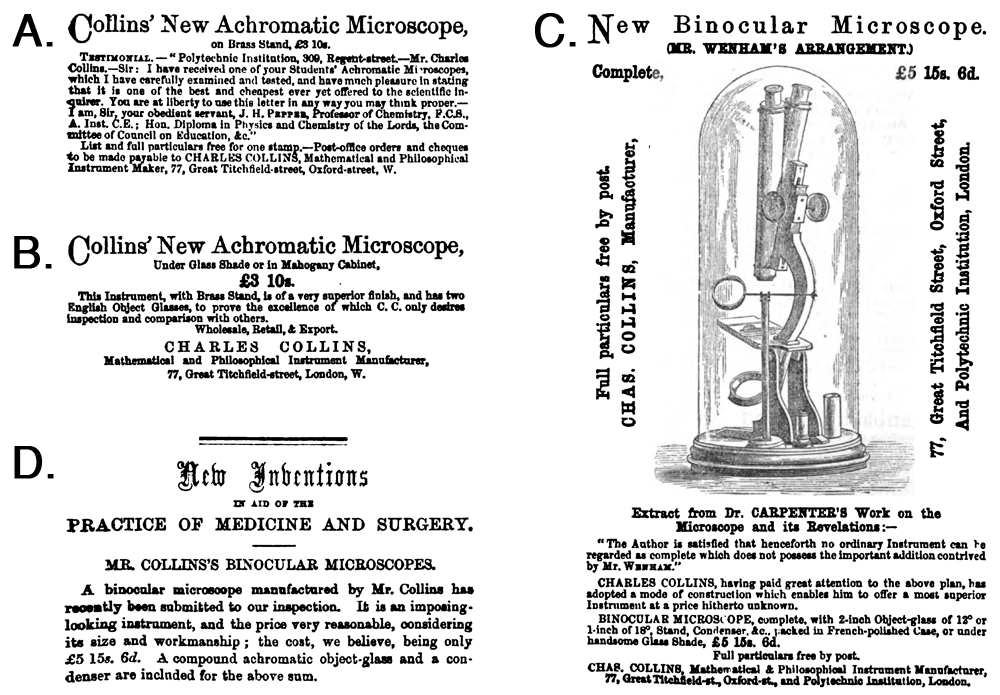
Figure 3. Advertisements and an announcement that appeared in The Lancet during 1863. These probably indicate the beginning of Charles
Collins’ business. Two microscopes were offered, a monocular for 3 pounds, 10
shillings, and a binocular for 5 pounds, 15 shillings, 6 pence.
(A) May 2, June 6, June 20 and July 4.
The testimonial was written by Collins’ boss at the Royal Polytechnic
Institute, J.H. Pepper.
(B) July 18, Aug 1, Aug 15, Aug 29, Sept. 12 and Sept. 19
(C) Sept. 26, Oct. 3 and Nov. 7. Note that Collins gave his addresses as 77 Great Titchfield and the Polytechnic Institute, indicating that
he probably kept his old job at the Institute for a while after opening his own shop.
(D) A notice from the editors of The Lancet on Collins’ binocular microscope (as shown in panel C), published Dec. 12.
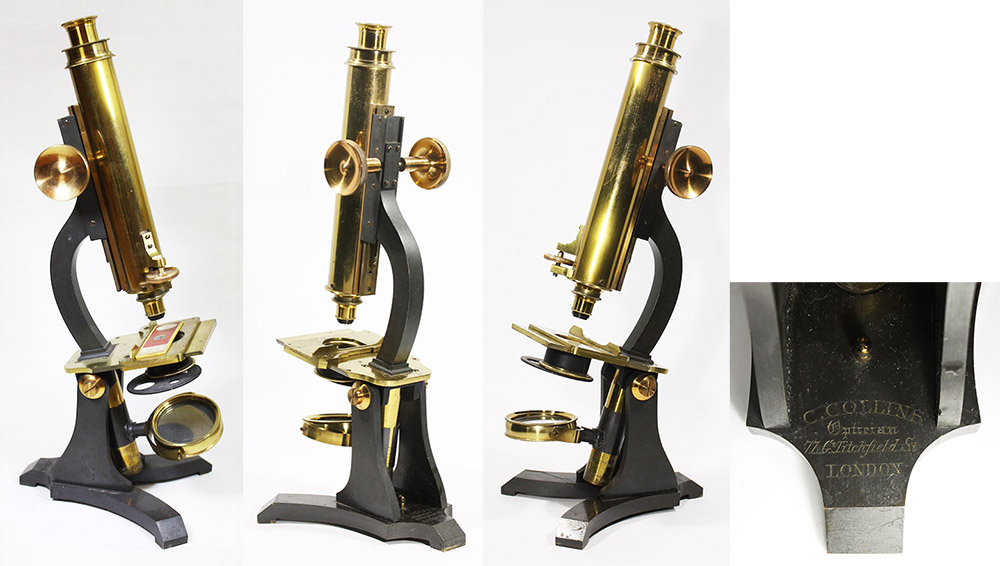
Figure 4. A monocular microscope made by C. Collins. The foot is engraved with the address 77 Great Titchfield Street. The style is identical to the binocular instrument shown in Figure 3D, and is probably the microscope advertised by Collins in his initial, 1863 advertisement shown in Figure 3A.
The following year, Collins put
out a new model of binocular microscope, described as following Professor
Harley’s plan (Figure 5). The Harley microscope probably replaced the
model illustrated in Figure 3C (above). This first Harley model largely copied the style that Andrew Ross had made popular at that time. A distinctive improvement over Collins’ earlier model microscopes was transfer of the fine focus from the body tube to the arm, which improved stability. The Intellectual
Observer described the Harley as “a
large, handsome instrument, presenting some novel and ingenious peculiarities.
It carries two object-glasses on a dovetailed arm, sliding in a groove, so that
a change of powers can be instantly made. We should think this mode of
construction would require even greater attention to accuracy than the ordinary
double nose-piece; but, if accurately centered, it affords certain advantages.
The next important speciality is the facility with which the polarizer (carried
under the stage) can be brought into play, and the analyser made to replace the
prism of the binocular arrangement, by drawing in or out the slide which
carries both. In certain chemical and medical investigations, these
arrangements are very convenient, and several eminent members of the medical
profession have expressed great satisfaction with Mr. Collins' labours.
The stage is furnished with a magnetic bar, and if likewise supplied
with the ordinary object-holder and clip, its range of utility would be increased, as the magnetic plan, though good for slides, is not well adapted
for heavier articles like zoophyte troughs. We carefully examined the optical
part of one of these instruments and found it fully equal to all ordinary
requirements. Mr. Collins has taken an honourable
place amongst those opticians who offer students a great deal of convenience
for a small sum of money. In first-rate, costly instruments all kinds of wants
are provided for; but where price is an object, the purchaser must consider
what he stands most in need of, and what he can best dispense with. Under such
circumstances tastes and necessities will lead to much difference of opinion,
but it would be admitted on all sides, that Mr. Collins' binocular
is well entitled to consideration, and likely to meet the wishes of a large
class”.
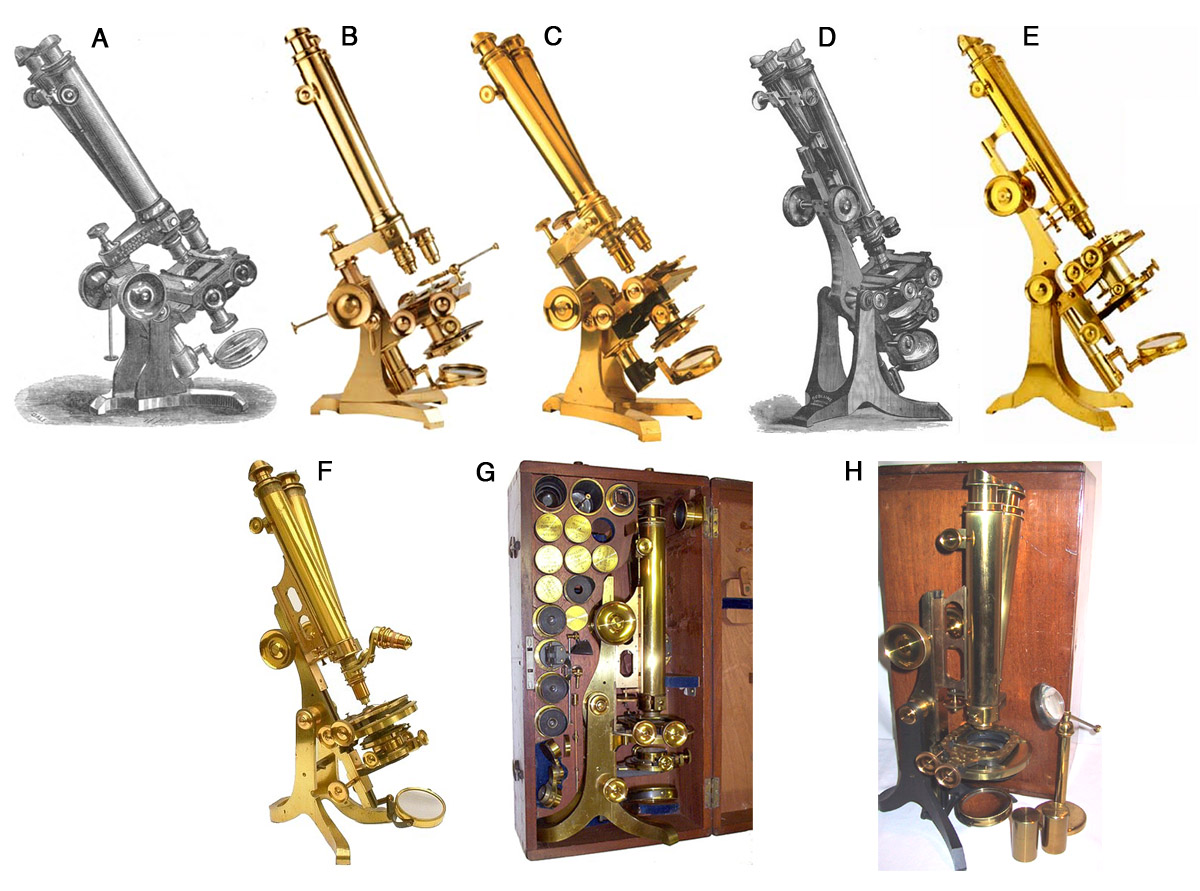
Figure 5. The Harley binocular microscope, by Charles Collins.
Contemporary woodcut prints show early (panel A, identical microscopes were
illustrated in 1864 and 1869) and a later version (panel D, from an 1889
illustration). Panel B shows a surviving Harley of the early model, engraved
with the address 77 Great Titchfield Street, dating it to between early 1864
and the end of 1870. Panel C shows another microscope of the same style as B, except for the addition of a second focusing knob, which is engraved
with Collins’ Great Portland St. address, indicating production after January,
1871. The remainder of the illustrated microscopes are also marked 157 Great
Portland Street. Note the extensive redesign that was implemented some time
after 1871. A surviving microscope with the same foot style as the 1889 woodcut
is shown in panel E. The lower row shows two Harley microscopes with a “Crouch”
foot in lacquered brass (F and G) and blackened brass (H). The Crouch-footed design may have predated the ca. 1889 style of foot seen on microscopes D and E, as an 1880 advertisement for another of Collins’ microscopes shows a similar, Crouch-foot style (Figure 9, below). William Carpenter, in his 1868, fourth edition of the
Microscope, wrote favorably of the contoured side shades that Collins added to
his eyepieces, which blocked side light from entering the microscopist’s eyes.
Panel B is adapted from
http://www.arsmachina.com/collins1.htm.
Panel C is adapted from
http://www.arsmachina.com/collins_binocular.htm.
Panel E is adapted from
http://www.arsmachina.com/collins_harley.htm.
Panels F and G are adapted from
http://www.antique-microscopes.com/photos/collins.htm.
Panel H is adapted from
http://www.gemmary.com/con/UK/UK-767.html.
Additional pictures and descriptions of early Collins’ Harley model microscopes can be seen in The Billings Microscope Collection. One of the Harley microscopes from that collection is currently on exhibit (2011) at the U.S. National Museum of Health and Medicine, Washington, D.C.
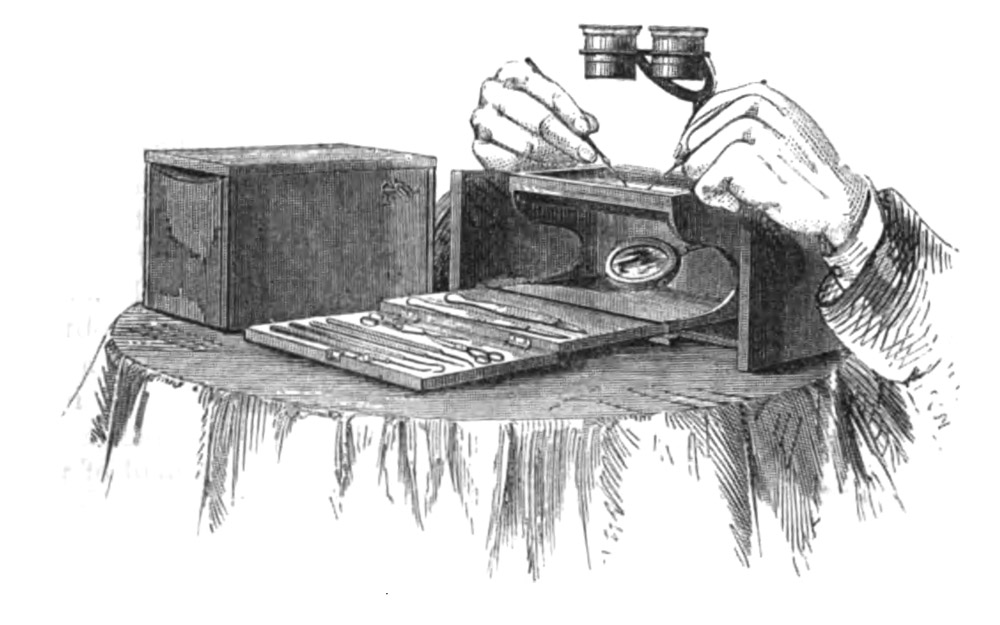
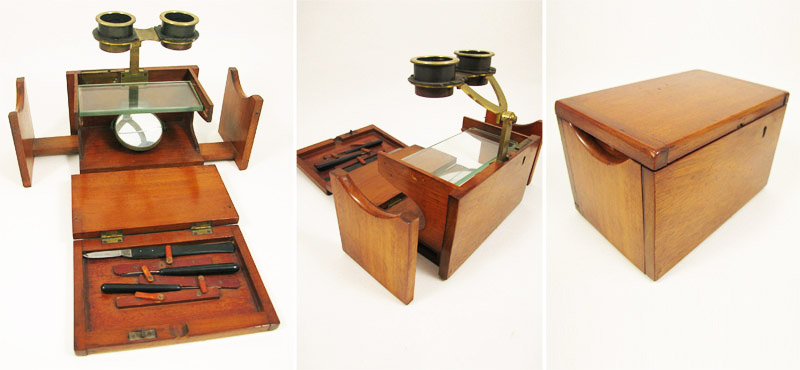
Figure 6A.
By 1865, Collins had begun advertising “Doctor Lawson’s binocular dissecting microscope” (Figure 6). This was primarily made of wood, with a horizontal plate glass stage for dissecting, a mirror below and a pair of eyepieces. The binocular vision gave depth of field, and was a great improvement of monocular dissecting scopes. One side of the wooden box folded out, away from the user, to display an array of dissecting tools, in easy reach. The narrow sides pulled out from the center, forming arm rests. Advertisements indicate that this microscope was made for several decades.Top, an 1865 etching of Doctor Lawson’s binocular dissecting microscope, from the Quarterly Journal of Microscopical Science. Below, a surviving instrument.
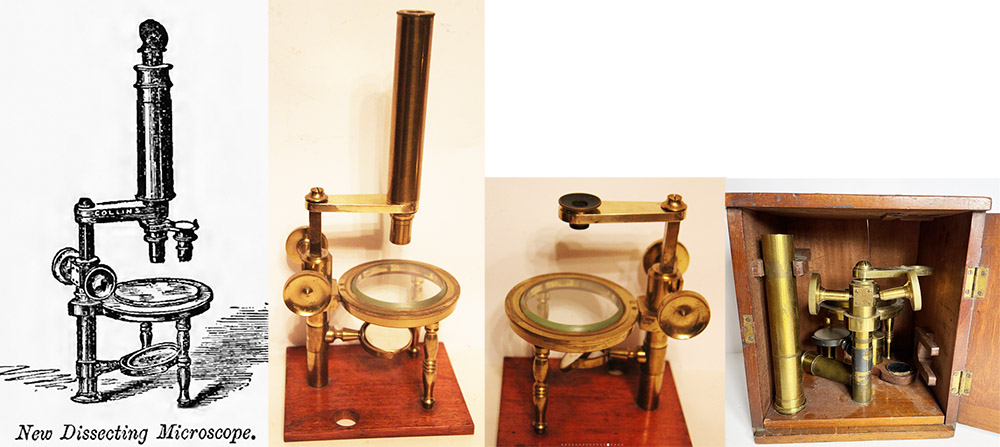
Figure 6B.
Charles Collins introduced another form of dissecting microscope ca. 1866. It was described by "The Monthly Microscopical Journal" in 1869: "A New Dissecting Microscope - We have examined an instrument recently brought out by Mr. Chas. Collins, and which we think will be found very useful by those who dissect under the higher magnifying powers. It has (as seen in figure) a tripod foot, and a large glass stage which is movable, and can be replaced by a trough of gutta-percha or other material. The peculiarity of the instrument lies in the fact that Mr. Collins has adapted to the eye-piece a compound prism which acts as erector, and at the same time throws the rays from a vertical to a horizontal position, so that the head need not be stooped. We had thought that such an arrangement would have absorbed too much light, but we found dissection under the inch and two-inch extremity easy and comfortable". Images adapted for nonprofit, educational purposes from internet sale sites.
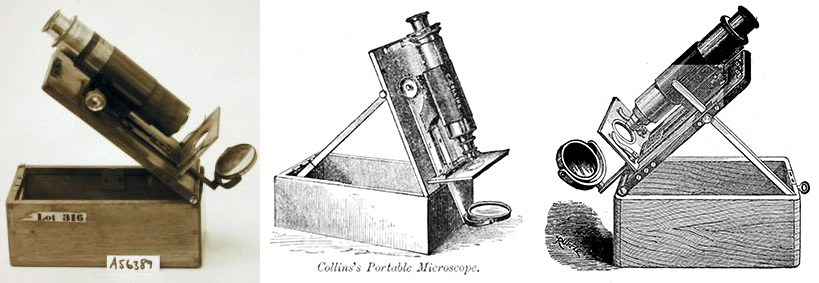
Figure 6C.
Collins' "Portable Microscope" was introduced ca. 1869, described by "The Monthly Microscopical Journal": "Mr. Collins has constructed a portable microscope which is especially intended for those who purchase some of his larger instruments. When packed it forms an oblong mahogany box, about 6 inches long by 3 inches wide, and 24 high. It may easily be carried in the great-coat pocket. It is difficult to explain its construction, which is partly shown in the adjacent figure. The microscope body is attached to the inner side of the cover of the case. This cover, on being lifted up, is made to rotate on a central pivot, so that its inside is loosened out. The degree of slope is obtained by an oblique bar, which slides in a second one, and which supports the lid and can be clamped at any angle. The stage is small, and the mirror draws out from beneath it. The objectives and eye-piece are those of this maker's other instruments. We have done some work with this instrument, and found it very handy, in the absence of our larger microscope". The engraving on the right is from an 1885 issue of the "Journal of the Royal Microscopical Society", suggesting that Collins still made this model at that time. Photograph adapted for nonprofit, educational purposes from Brian Bracegirdle's "Science Museum, London" CD.
Charles Collins joined the Quekett Microscopical Club in 1865, and the Royal Microscopical Society in 1866. Collins remained a member of Quekett through 1878. He was still listed on the membership rolls of the RMS in 1892, the last record I could locate (any information on how much longer Collins was a member would be appreciated). At the July 24, 1866, Annual Meeting of the QMC, it was announced that, “the formation of a Cabinet of Objects has been most successful, the following slides having been presented, viz.: "From Mr. Hislop, 39 slides; Mr. Marks, 24; Mr. Quick, 24; Mr. Archer, 11; Mr. Hailes, 8; Mr. Bockett, 6; Mr. Bywater, 6; Mr. Breese, 5; making the number 123; and through the liberality of Mr. Charles Collins, in presenting the Club with a cabinet, those slides are now rendered accessible to the members on the evenings of meeting”. While a member of the QMC, Collins exhibited microscopes and a variety of microscopical specimens, including “seed of Nemesia”, “wing of dragon fly”, and “various greenhouse insects”. Collins was undoubtedly a competent slide maker, so the exhibited specimens may have been his own productions. They may also have included commercial preparations, and, since Collins sold microscope slides from his shops, might have served as advertisements of objects he had for sale (Figure 7).
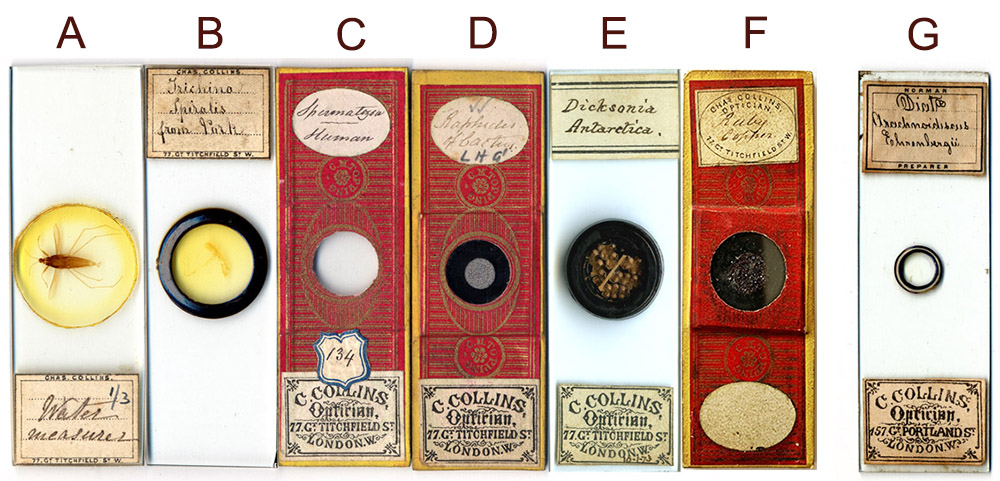
Figure 7. Microscope slides sold by Charles Collins. The
addresses on slides A-F indicate sales between 1863 and 1870, while slide G was
sold after the start of 1871. Slides C, D and F were made by Charles M. Topping,
and slide G came from John T. Norman. The handwriting on slide B resembles that of a member of the Norman clan of slide makers. That suggests that slides A and E were probably also made by someone other than Charles Collins. Since Collins was a skilled optician, it makes sense that he would have spent his working hours grinding lenses rather than making slides for sale.
Jabez Hogg’s sixth edition of The Microscope, 1867, featured several of Charles Collins’ creations, including the Harley binocular (Figure 5, above), Lawson’s dissecting microscope (Figure 6, above), a binocular student’s microscope (Figure 8, below), the Bockett lamp (Figure 10, below) and microscopist’s cabinets (Figure 11, below). Later, monocular versions of the student’s microscope are described in Figure 9.
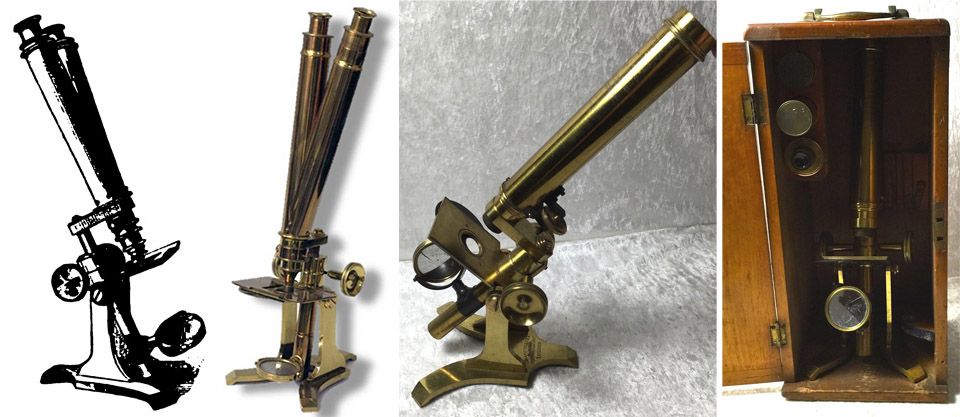
Figure 8. Charles Collins’ "Student" microscope, circa 1867. This simpler microscope sold for much less than the Harley model, but clearly provided fewer features. On the left is an engraving of the binocular version, as illustrated in Hogg’s sixth, 1867 edition of The Microscope. Next to the engraving is a photo of a surviving binocular "Student" microscope. On the right are two pictures of a monocular version of the "Student" microscope. It came with a simple case with space for one eyepiece and two objective lenses, and a bull’s eye condensor (now missing from this example).
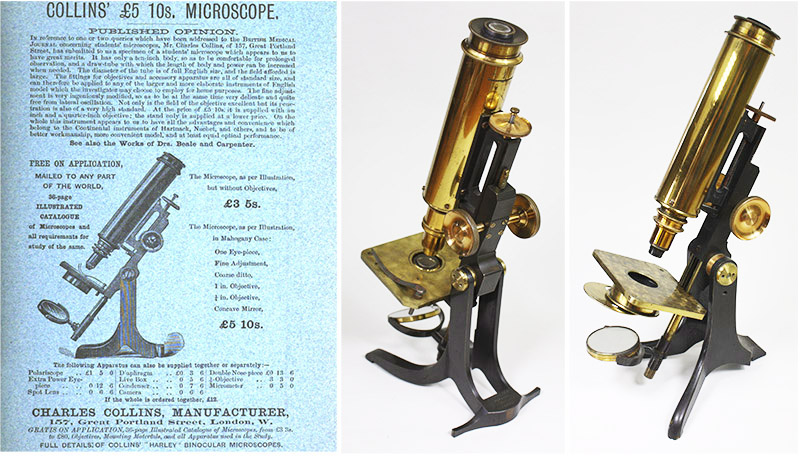
Figure 9. Later versions of the Collins student microscope,
as monocular instruments. It was noted that Collins made the tube of these microscopes uncommonly large in diameter – this was so eyepieces from all his
microscopes would be interchangeable.
(left) An advertisement that appeared in the Journal of the Royal Microscopical Society, 1880. The woodcut shows a modified Crouch-style foot.
(center) A surviving microscope of this model. The advertisement shown in panel A dates this instrument to circa 1880.
(right) A Collins student microscope with the same style foot as seen in Collins’ 1889 advertisement for a Harley model (see Figure 5, above). Two other examples of this style microscope can be seen at http://www.arsmachina.com/collinsm.htm and The Billings Microscope Collection, page 216.
Both of the illustrated microscopes are engraved on the foot with "157 Great Portland Street", Collins’ location
between 1871 and approx. 1900.
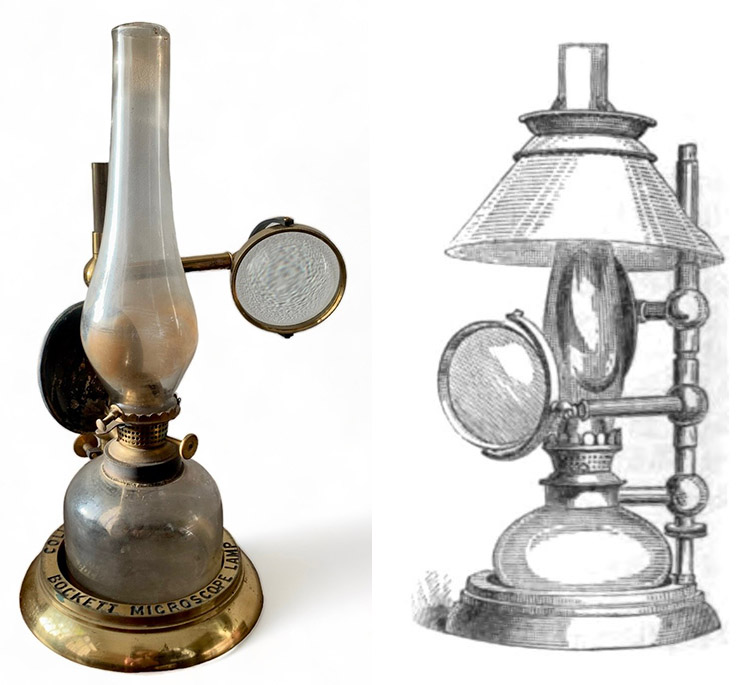
Figure 10. A surviving Collins’ “Bockett” microscope lamp, and an illustration from Hogg, 1867. A condenser lens serves to focus the lamp’s light on a specimen or the microscope mirror. Collins later produced these lamps with a metal shade. Reproduction "Bockett" lamps are often encountered nowaday, while originals are relatively scarce. As noted in https://dittrick.pastperfectonline.com/webobject/86547901-D582-4FCA-BC34-164045946384, reproductions can be identified by the engraving on the base not being filled with black paint, the lamp having a clear instead of blue glass chimney, presence of a useless appendage attached to the center, and the lamp generally being unused, with lightweight brass fittings.
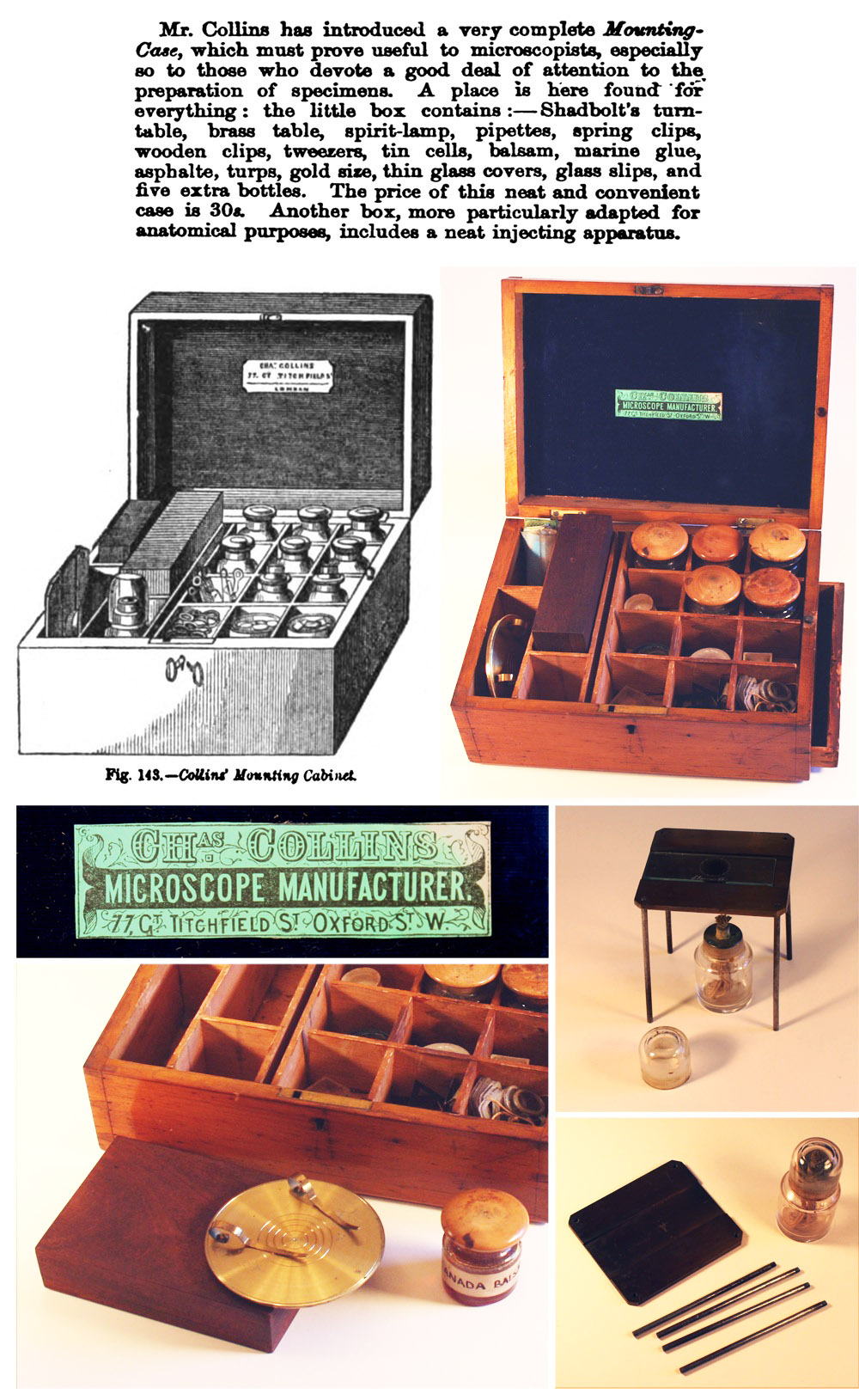
Figure 11. Collins’ microscopists’ mounting case. Description
and woodcut are from Jabez Hogg’s 1867 edition of The Microscope. An extant
case is also shown, with a Great Titchfield Street label identifying it as
having been made before 1871. This compact case included a ringing table, a
collapsible warming table (the legs unscrew), alcohol lamp, several bottles of
fluid supplies, metal rings and other useful equipment and supplies. A shallow
drawer opens to one side, to hold additional apparatus such as forceps and
diamond scribe. Another such case, with a post-1871 Great Portland Street
label, can be seen at http://www.victorianmicroscopeslides.com/accessories.htm
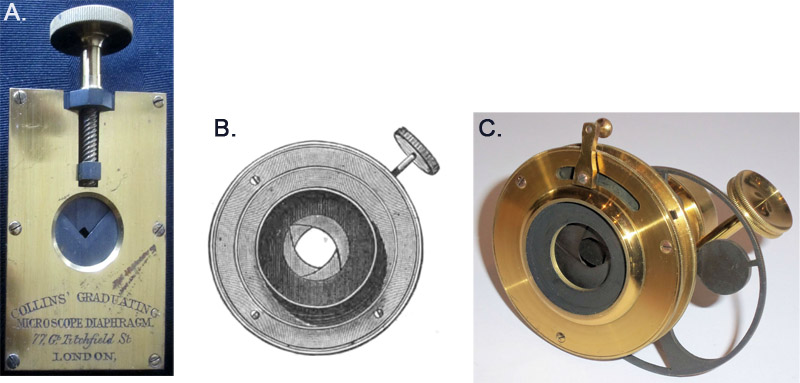
Figure 12. Two versions of Collins’ graduating diaphragm.
(A) An early version, with two opposing plates, that slide apart/together to form a square aperture.
(B) An advanced version, that contains 4 adjusting leaves. From a woodcut that was published in William Carpenter’s 1868 edition of The Microscope and its Revelations.
(C) An apparently later model, which accompanied a ca. 1871 Harley model binocular microscope. This version has added a ring of stops, and an adjusting lever. On Collins’ diaphragm, Carpenter wrote, “So great an advantage is often derivable from a gradational reduction or augmentation of the light, that the Microscopist who
desires to avail himself of this will do well to provide himself with one of
the forms of Graduating Diaphragm which have been recently introduced. That
long ago invented by Dollond for Telescopic purposes is equally applicable to
the Microscope; the circumstance that its aperture is square, instead of round,
not constituting any practical objection to its use. In another form,
introduced by Mr. Collins . . . four shutters are made, by acting on a lever-handle,
to move inwards simultaneously, so as to narrow the aperture, the shape of
which always remains more nearly circular than square. And in the 'Iris
Diaphragm' recently devised by Mr. Brown, the multiplication of the number of
shutters makes the aperture practically circular”.
Charles Collins also made highly specialized equipment, probably to order. In 1868, The Popular Science Review described a “Binocular Spectrum Microscope”, which Collins had built for William Crookes, ”This instrument, which was described a few nights since at the Royal Society by Mr. Crookes, and which was favourably spoken of by Dr. Carpenter, is made by Mr. Charles Collins, of Great Titchfield Street, W. The principal features are the sub-stage and the box of prisms. The former carries a sliding-plate to hold the slit and apertures, a spring stop and screws for adjusting them, and a reversed object-glass. The slit and this object-glass are about two inches apart, and if reflected light is passed along the axis of the instrument, the object-glass forms a very small image of the slit in front of it. A milled head moves the whole sub-stage, and screws bring the image of the slit to any part of the field. Beneath the slit is an arrangement for holding an object of irregular surface or dense substance. The stage has a concentric movement, so as to permit the object to rotate, and enable the image of the slit to pass through it in any direction. The direct-vision prisms consist of three flint and two crown, fitted in a box screwed into the end of the microscope. By means of a pin they are thrown in or out of action. The object-glass screws on in front of the prism-box. By taking the illumination from the sky or a white cloud, Fraünhofer’s lines are visible, and by direct sunlight they are seen in great perfection; the dispersion is sufficient to cause the spectrum to cover the whole field, and the achromatism of the lenses being nearly perfect, the lines from B to G are practically in the same focus. A double-image prism near the slit enables two spectra to be seen, oppositely polarised, and the variations in the absorption lines are at once visible. A Nicol's prism as polariser, and another as analyser, can be connected, and these enable the brilliant colours shown by some crystalline bodies, when seen by polarised light, to be examined”.
The 1871 census of England, taken during March of that year, recorded Charles as living at 17 Park Villas, Hammersmith, London. Charles was then 33, and had married at some unknown time past, to Louisa, now age 28. Charles and Louisa appear never to have had children. Charles’ brother William lived with them, and was listed as head of the household. William had been married, but his wife had died before 1871. William was recorded as being a “commercial traveller in the book trade”. Charles was described as being a “microscope maker, employing 8 men and 5 boys”.
At the beginning of 1871, Charles moved his retail shop to 157 Great Portland Street (Figure 13). This was about a two minute walk from his former store. He retained the Great Titchfield location for some time afterward, as his factory. Other advertisements indicate that Collins had a business office at 157 Great Portland as early as 1868, but that does not appear to have been a sales location.

Figure 13. An 1871 advertisement indicating that one can
reliably date equipment marked “157 Great Portland Street”, as having been
manufactured after the beginning of 1871, and that marked “77 Great Titchfield
Street” as being pre-1871.
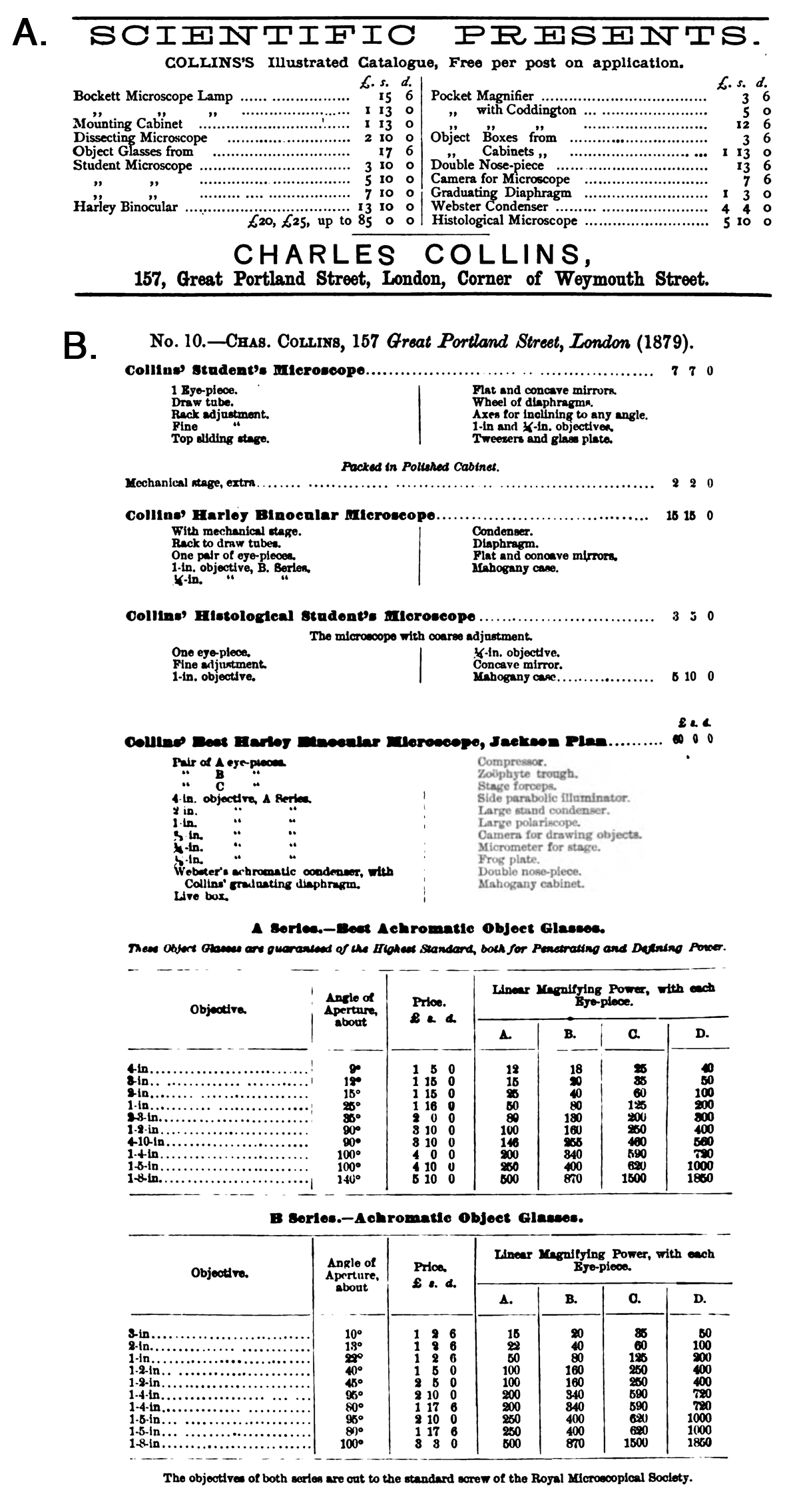
Figure 14.
Lists of microscopes,
lenses and equipment produced by Charles Collins, with prices. (A) An 1878 advertisement from
Hardwicke’s Science-Gossip. (B) The Microscope and Microscopical Technology, by
Heinrich Frey, George Rogers Cutter, 1880.
The 1881 England census again found Charles, Louisa and William living in Hammersmith. Charles was listed as head of household this time (this may simply reflect who answered the door on census night). Charles was listed as being an “optician master”, employing 5 men and 1 boy. The “boy” was probably his 19 year old nephew, Charles Collins Jr., who was recorded as being an apprentice microscopist in the same census. Three years later, this nephew commercially produced microscope slides and sold them from his home in a London suburb and from Uncle Charles’ shop in the downtown (Figure 15). That business lasted for approximately 4 years, then Charles Jr. turned his attention to bookselling.
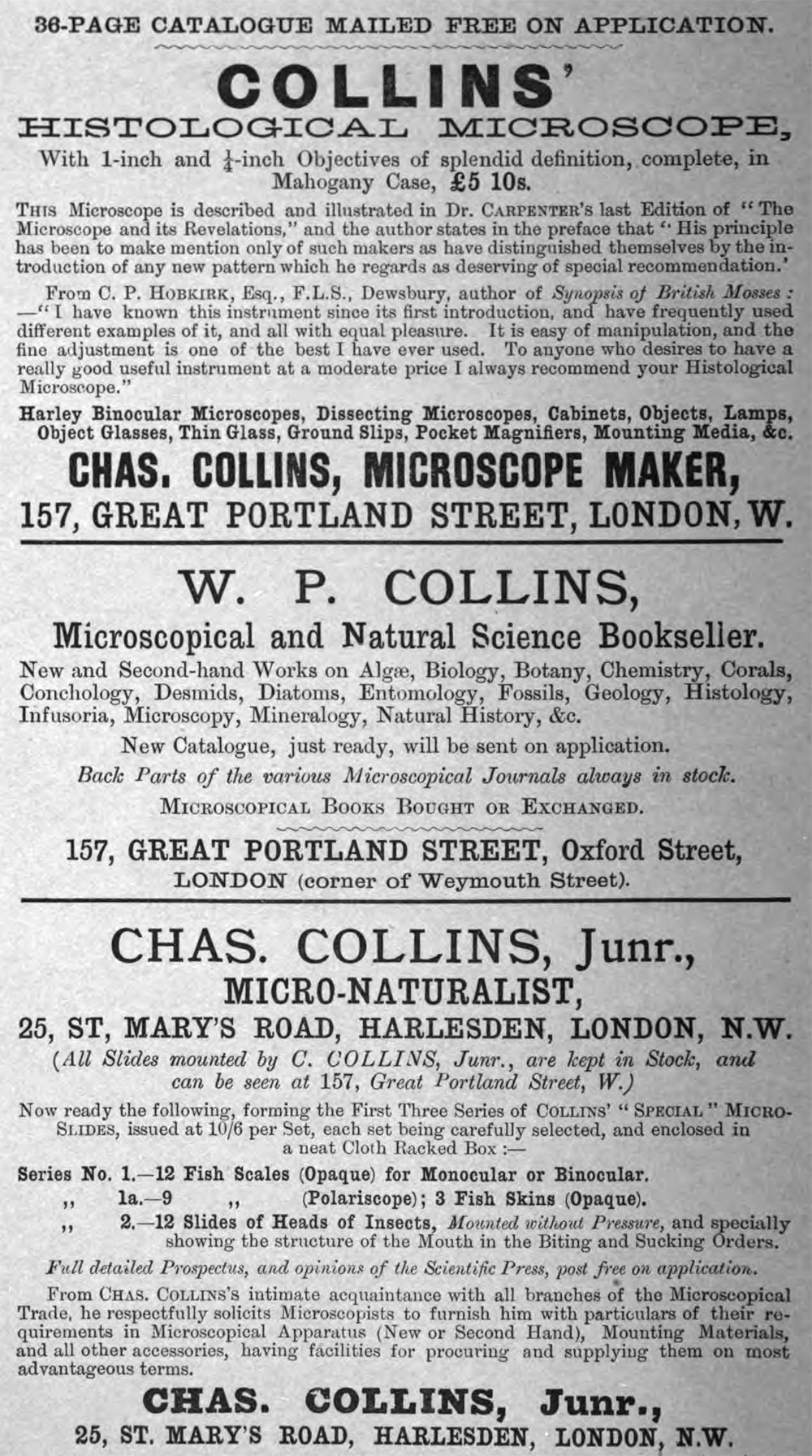
Figure 15. Advertisements from the inside cover of the Journal of Microscopy and Science, 1885.
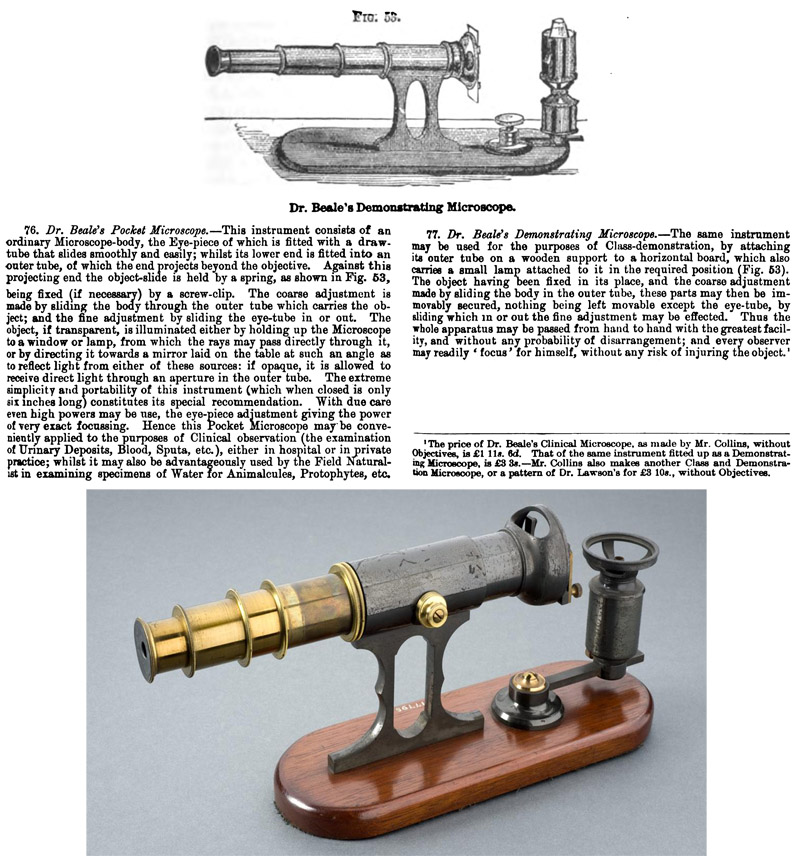
Figure 16. Etching and description of Dr. Beale’s Clinical/Demonstrating Microscope as made by Charles Collins. Adapted from W. Carpenter’s The Microscope and Its Revelations, edition 6, 1883. Also shown is a photograph of surviving Beale’s Microscope, from the Science Museum (U.K.),
http://www.sciencemuseum.org.uk/broughttolife/objects/display.aspx?id=4663.
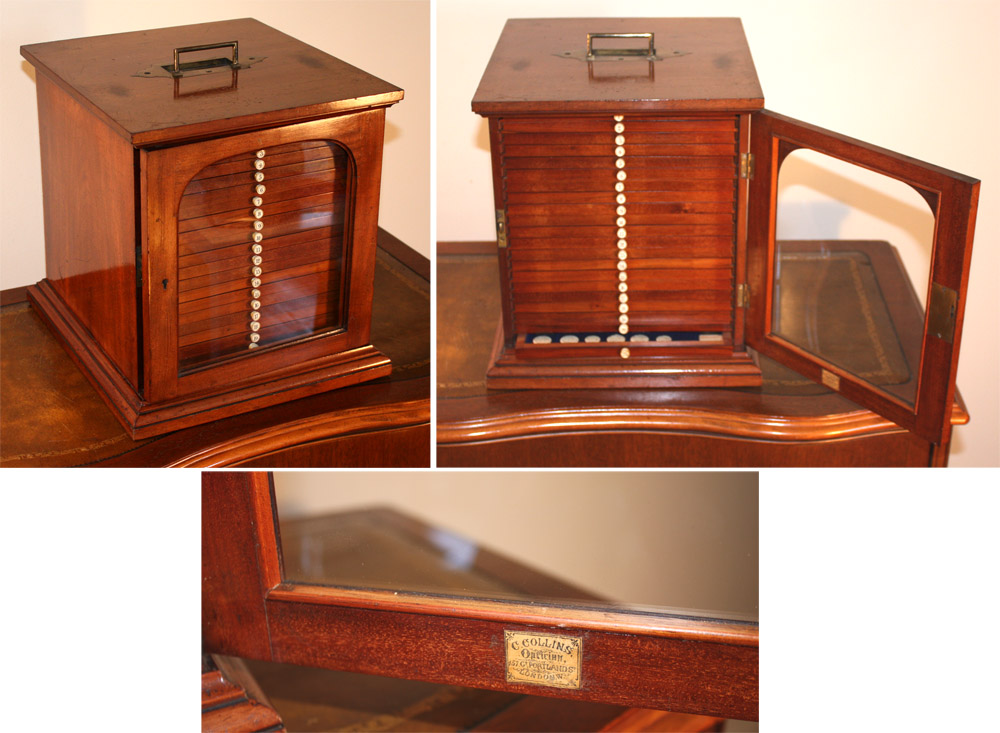
Figure 17. A circa 1880 microscope slide cabinet, sold by Charles Collins, 157 Great Portland Street. The label inside the cabinet door is identical to those Collins placed on slides (Figure 7).
By 1891, the Collins household (Charles, Louisa and William) had moved to 213 Albany Street, London. An Alfred lived with them, apparently Louisa’s widowed father. As on all other censuses, the Collins enjoyed the services of a live-in domestic servant. 1901 found Charles and Louisa at 72 Haverstock Hill, Hampstead, while William boarded at Durrant’s Hotel, George Street, St. Marylebone.
Charles Collins’ business shows signs of decline by the early 1890s. Advertisements from that decade described Collins as selling second-hand equipment, and offering to make repairs, suggesting that new equipment no longer sold at levels sufficient to make ends meet (e.g. Figure 18). In 1891, brother William, also operating from 157 Great Portland, advertised in a catalog of used book stores, indicating that his stock was no longer made up of new books. The 1899 Post Office Directory of London listed Collins Charles, maker of mathematical and philosophical instruments and barometers etc., as operating from 157c, Great Portland Street. The 157 address had been subdivided into at least three separate businesses, again indicating a reduction in Charles’ sales. The 1910 Post Office Directory of London indicated that Charles’ business had moved down the street to 148 Great Portland Street. The 1915 Post Office London Directory indicated another move, to 23 Great Portland Street. The 1911 census recorded Charles Collins as being an “optician, sight testing, spectacles”, suggesting that his business at that time had primarily been reduced to fitting eyeglasses.

Figure 18. Advertisement from an 1892 issue of Hardwicke’s Science-Gossip.
The 1915 Post Office Directory listing is the last record I found on Charles Collins. At that time, he would have been 78 years old. It is reasonable to assume that Charles died within a few years of this date.
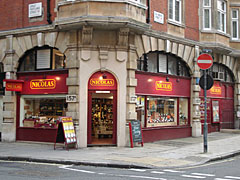
Figure 19. A modern photograph of 157 Great Portland Street,
London. This corner location would be a premium location for a business.
Collins’ later locations, at 148 and 23 Great Portland, are located in the middles of their blocks.
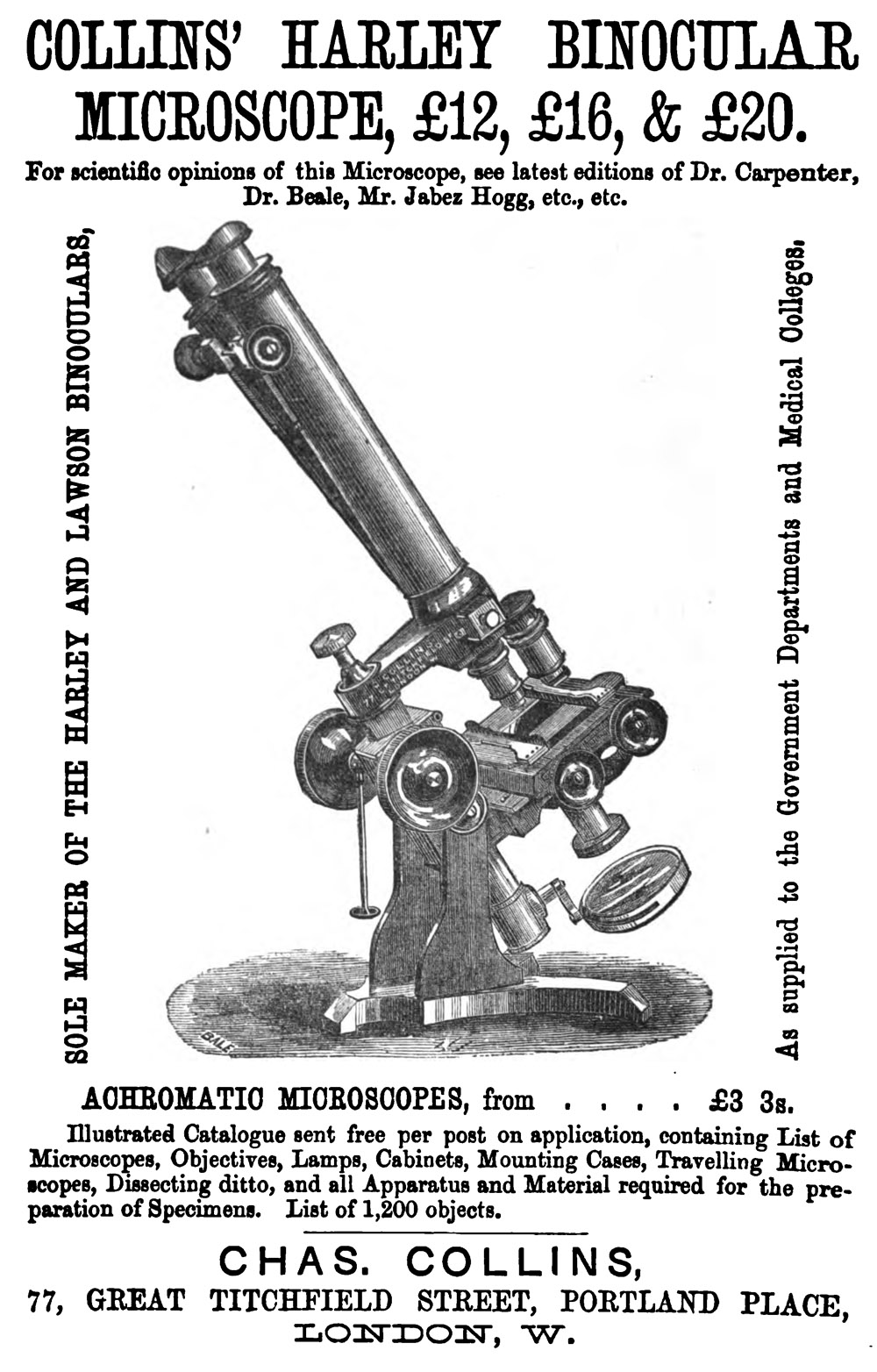
Figure 20. Full-page advertisement from The Microscope, 3rd
edition, by Mrs. F. Marshall Ward, 3rd edition, 1869.
Acknowledgements
Many thanks to Allan Wissner, Rick Blankenhorn, Richard Courtiour and numerous anonymous collectors for providing photographs of Collins microscopes and equipment.
Resources
The Athenaeum (1854) Description of dramatic readings, etc. to be held at the Royal Polytechnic Institute, Part 2, page 1306
The Billings Microscope Collection, second edition (1974) Pictures and descriptions of early Harley model microscopes on pages 137-140, and of a later student model on page 216
Brande, W.T. (1867) A Dictionary of Science, Literature and Art, new edition, Longmans, Green and Co., London, Volume 3, page 82
Brock, William Hodson (2008) William Crookes (1832-1919) and the Commercialization of Science, Ashgate Publishing, Aldershot, Hampshire, page 116
The Bookseller (1859) Bankrupts, Feb 24
British Medical Journal (1868) Advertisement, Volume 2, October 24 issue
Carpenter, William B. (1868) The Microscope and Its Revelations, fourth edition, John Churchill and Sons, London, pages 59, 64, 82, 83, 107, 111 and 140-142
Children, John G. (1847) On the use of a mixture of spirit of wine and camphine, as a light for optical purposes, The London, Edinburgh and Dublin Philosophical Magazine and Journal of Science, pages 179-181 (regarding C.W. Collins)
Christening record of Charles Collins (1837) June 21, 1837, Christened Sept 29, 1837, Saint Pancras Soper Lane, London
Christening record Henry Edward Collins (1835) born February 5, 1835, Christened March 15, 1835, Saint Pancras Soper Lane, London
Christening record of William Papprill Collins (1832) born October 14, 1832, Christened Nov. 11, 1832, Saint Mary Le Bow
Clegg, James (1891) Advertisement for William P. Collins, The Directory of Second-hand Booksellers, page 17
Collins, Henry G. (1861) Electro-block printing, The Civil Engineer and Architect's Journal, Vol. 24, page 27
Collins, Charles W. (1853) The Hand-book of Photography: Illustrating the Process of Producing Pictures by the Chemical Influence of Light on Silver, Glass, Paper and other surfaces, with Instructions for the Preparation and Use of the Materials Employed, described in: Anthony's Photographic Bulletin, (1886), Volume 17, page 297
Dyos, H.J., David Cannadine, and David Reeder (1982) Exploring the Urban Past: Essays in Urban History, Cambridge University Press, Cambridge, pages 193-195
Ellis, Robert (1851) Official Descriptive and Illustrated Catalogue of the Great Exhibition of the Works of Industry of all Nations, Volume 1. Entry 459: Ibbetson, pages 463-464
England vital statistics, including census, birth, marriage and death records, accessed through ancestery.co.uk
Frey, Heinrich and G.R. Cutter (1880) The Microscope and Microscopical Technology, William Wood and Co., New York, pages 639-640
Hardwicke’s Science-Gossip (1868) Advertisements, Volume 4, pages viii and cxx<
Hardwicke’s Science-Gossip (1878) Advertisement, Volume 14, page iii
Hardwicke’s Science-Gossip (1880) Advertisement, Volume 16, page lix
Hardwicke’s Science-Gossip (1884) Advertisement, Volume 20, page cxiv
Hardwicke’s Science-Gossip (1885) Advertisement, Vol. 21, page x
Hardwicke’s Science-Gossip (1892) Advertisement, Volume 28, page lxxxii
Hardwicke’s Science-Gossip (1893) Advertisement, Volume 29, page x
Hardwicke’s Science-Gossip (1897) Advertisement, New Series, Volume 3, page vi
Hogg, Jabez (1867) The Microscope, sixth edition, pages 94-98, 184-185, and 254
Intellectual Observer (1864) Collins’ binocular microscope, Volume 5, page 225
Intellectual Observer (1866) Advertisements from Charles Collins, multiple issues
Journal of Microscopy and Natural Science (1885) Advertisements on the inside of covers, Vol. 4, January (part 13), July (part 15) and October (part 16)
Journal of the Postal Microscopical Society(1882) Advertisement inside front cover, Volume 1, Issue 2, June 24
Journal of the Royal Microscopical Society (1880) Advertisement inside back cover, Volume 3, April issue
Journal of the Royal Microscopical Society (1885) Collins' Portable Microscope, Volume 5, page 701
Journal of the Royal Microscopical Society (1889) List of Ordinary Fellows, page xlvi
The Journal of Science, and Annals of Astronomy, Biology, Geology, Industrial Arts, Manufactures, and Technology (1864) advertisement from Charles Collins, October, page 13
Journal of the Quekett Microscopical Club (1870) Volume 2, Annual Soiree, pages 57-60, conversaziones, pages 123-124, 147, 150-156, and List of Members
Journal of the Quekett Microscopical Club (1871) Volume 2, The Soiree, pages 185-188 and List of Members
Journal of the Quekett Microscopical Club (1872) Volume 3, List of Members
Journal of the Quekett Microscopical Club (1873) Volume 3, List of Members
Journal of the Quekett Microscopical Club (1874) Volume 3, List of Members
Journal of the Quekett Microscopical Club (1876) Volume 4, List of Members
Journal of the Quekett Microscopical Club (1877) Volume 4, Conversazione, pages 328-331 and List of Members
Journal of the Quekett Microscopical Club (1878) Volume 5, List of Members
Journal of the Quekett Microscopical Club (1879) Volume 6, List of Members
Journal of the Society of Arts (1860) Catalogue of the Twelfth Annual Exhibition of Inventions, being a collection of articles recently invented, patented, or registered. Exhibited at the Society of Arts, Adelphi, during the spring of 1860, 145 Collins’s Patent Electro-Block Printing; Exhibited by the Electro-Block Company (Limited), 27, New Bridge-street, Blackfriars, E.C., Vol. 8, page 357
The Jurist (1860) William Papprill Collins and Henry Edward Collins, Paternoster-row, City, mapsellers, page 250
The Lancet (1852) Volume 1, Advertisements from Charles W. Collins, appearing in the Lancet General Advertiser, Issues 18 and 19.
The Lancet (1863) Volumes 1 and 2, numerous advertisements from Charles Collins, appearing in the Lancet General Advertiser beginning May 2.
The Lancet (1863) New Inventions in aid of the practice of medicine and surgery: Mr. Collins’s binocular microscopes, Volume 2, Dec. 12, page 683
The Lancet (1870) Advertisement, Volume 2, Sept. 24
The London Gazette (1860) In the Matter of William Papprill Collins and Henry Edward Collins, of 22, Paternoster-row, in the city of London, Mapsellers and Publishers, against whom a Petition for adjudication of Bankruptcy bearing date the 9th day of February, 1859…, Edition of March 20, page 1159
The London Gazette (1862) Henry George Collins and William Papprill Collins, of Hale-Mills, Staines, in the county of Middlesex, Fibre Manufacturers and Copartners, having been adjudged bankrupts under Petitions for adjudications of bankruptcy, filed in Her Majesty’s Court of Bankruptcy, in London, on the 11th day of June, 1862…, Edition of July 4, page 3409
The Law Advertiser (1831) Partnerships Dissolved: Collins Henry George, and Thomas Aynsley Cook, No. 10, Bishopsgate-street Without, London, bookbinders, stationers, &c., (dissolved) Oct. 13, Vol. 9, page 492
Marriage record of Henry George Collins and Matilda Papprill (1831) Saint Mary Woolnoth , London
The Mechanics' Magazine, Museum, Register, Journal, and Gazette (1837) Patent granted to Christopher Nickels, of Guildford-street, Lambeth, Surry, gent., and Henry George Collins, of Queenstreet, Cheapside, London, bookbinder, for improvements in bookbinding, parts of which improvements are applicable to the cutting paper for other purposes. Volume 28, page 223
Medical Times and Gazette (1864) advertisements, Volume 1, February 24
Medical Times and Gazette (1871) advertisement, Volume 1, January 7, page 30
The Mirror of Literature, Amusement, and Instruction (1844) Letter to the editor (regarding C.W. Collins), Vol. 2, number 6, page 103
The Monthly Microscopical Journal (1869) A new dissecting microscope, page 217
The Monthly Microscopical Journal (1869) Mr. Collins's portable microscope, page 218
National Museum of Health and Medicine, on the campus of the Walter Reed Army Medical Hospital, Washington, D.C., USA. It has much of the Billings Microscope Collection on display. Free admission, open almost every day of the year. If you appreciate historical microscopy and/or medicine, it is well worth a visit. http://nmhm.washingtondc.museum/
Nature (1869) Advertisement, Volume 1, page 39
Nature and Art (1867) The microscope, Volume 2, pages 180-185
The Popular Science Review (1869) The binocular spectrum microscope, Volume 8, pages 322-323
Post Office Directory of London, Part 4: Trades and Professional (1899) page 2237
Post Office Directory of London, Volume 1, Part 2 (1910) page 1745
Post Office Directory of London, Part 4: Trades and Professional (1915) page 1772
Quarterly Journal of Microscopical Science (1866) Reports of societies: The Quekett Microscopical Club, Volume 6, page 278
Quarterly Journal of Science (1865) advertisement, October issue, page 10
Royal Microscopical Society (1892) Charter and Bye-laws: List of Fellows 1892, Corrected to May 18th, page 29
Teesdale Mercury (1868) A thief detected through a dog, January 22, page 3
Ward, Mrs. F. Marshall (1869) The Microscope, third edition, Groombridge and Sons, London, Advertisement at back of book
Web Sites
Charles Collins’ microscopes and related equipment:
Harley microscope: http://www.antique-microscopes.com/photos/collins.htm
Parent site: http://www.antique-microscopes.com
Dr. Beale’s Clinical/Demonstrating Microscope:
http://www.sciencemuseum.org.uk/broughttolife/objects/display.aspx?id=4663
Harley microscope: http://www.arsmachina.com/collins1.htm
Harley microscope: http://www.arsmachina.com/collins_binocular.htm
Harley microscope: http://www.arsmachina.com/collins_harley.htm
Student’s microscope: http://www.arsmachina.com/collinsm.htm
Parent site: http://www.arsmachina.com
Microscopist’s box: http://www.victorianmicroscopeslides.com/accessories.htm
Parent site: http://www.victorianmicroscopeslides.com
A globe by Henry George Collins:
http://www.georgeglazer.com/globes/floor/collins.html
Current view of 157 Great Portland Street, London:
http://www.nicolas.com/en/magasin/london/greatportlandstreet-458-178-378.htm
Information on lantern slides produced by Charles W. Collins